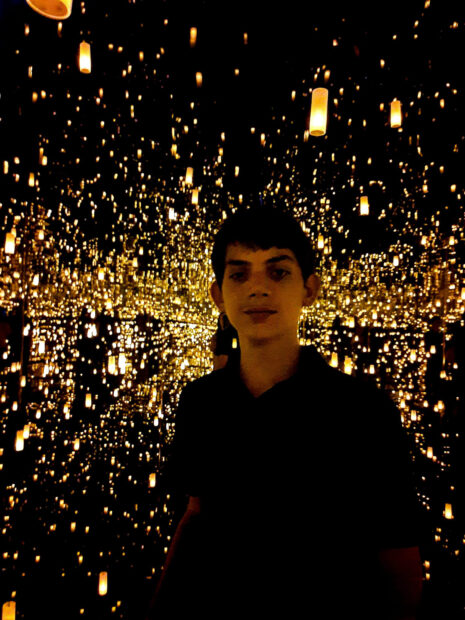Note from longtime Glasstire contributor, Betsy Huete: As part of an initiative to inspire competition and rigor in arts writing in education, one of my students’ written pieces will be featured on Glasstire each year. The following review of a Yayoi Kusama Infinity Room is by Alessandro Nardi, an eighth grader (at the time of writing) from Tanglewood Middle School in Houston ISD. For last year’s installment, please go here.

Eighth grader Alessandro Nardi standing in “Aftermath of Obliteration of Eternity” by Yayoi Kusama, on view at the Museum of Fine Arts, Houston
Infinity is indescribable, ever-expansive, and hard to understand, but through art, one can manage to enclose and capture it. A dazzling display of reflecting lights, Yayoi Kusama’s Aftermath of Obliteration of Eternity (2009), currently on view at the Museum of Fine Arts, Houston, is a curious installation, pulling us into its cryptic sense of endlessness, a tribute to the infinite cycle of mortality and rebirth.
This specific piece is an Infinity Room, one of the many that Kusama has produced throughout her career. These works generally consist of mirrors and lights, which play off one another, creating an environment that is enticing and confounding. Kusama’s work has been inspired by her hallucinations, which she’s faced since her early childhood. These hallucinations would appear to her as if a certain subject would multiply, expand, and eventually consume her, a process that she later deemed “self obliteration.” Using art as a coping mechanism, she eventually left for New York to advance her career. Kusama is most known for her usage of polka dots in her sculptures and installations.
Upon entering Aftermath of Obliteration of Eternity, lights slowly illuminate and multiply, as if being awakened. Their flickering represents mortality, and the never-ending stream of these lights can constitute that something larger is at play, be it a religious figure or something more scientific. The festival of Toro Nagashi plays an inspirational part in this piece, as its participants commemorate the dead by lighting lanterns and setting them adrift in the rivers at dusk. This is wonderfully represented by the hanging lanterns seemingly disappearing into the looming darkness. The piece’s mirrors create an intoxicating illusion of depth as well; despite being contained in a tiny room, the viewer is enticed to run off into its distance.
Each light is intended to represent a life, but the mere flickering doesn’t read as an apt metaphor. Perhaps it would make more sense for the lights to get brighter to reflect the ups and downs one experiences in human existence. And in certain spots within the room, one can detect a pattern of lights, betraying a more organic pattern of mortality.
Despite the few downsides, Aftermath of Obliteration of Eternity retains an intoxicating depth and simplicity. Mortality and endlessness may be polar opposites, but through this piece, both can coexist.
Aftermath of Obliteration of Eternity is on view indefinitely at the Museum of Fine Arts, Houston’s Kinder Building.
Alessandro Nardi is an eighth grader at Tanglewood Elementary in Houston and a student of Glasstire contributor, artist, and educator Betsy Huete.



2 comments
this art review has changed my life in ways i never could have concieved
well done, Alessandro